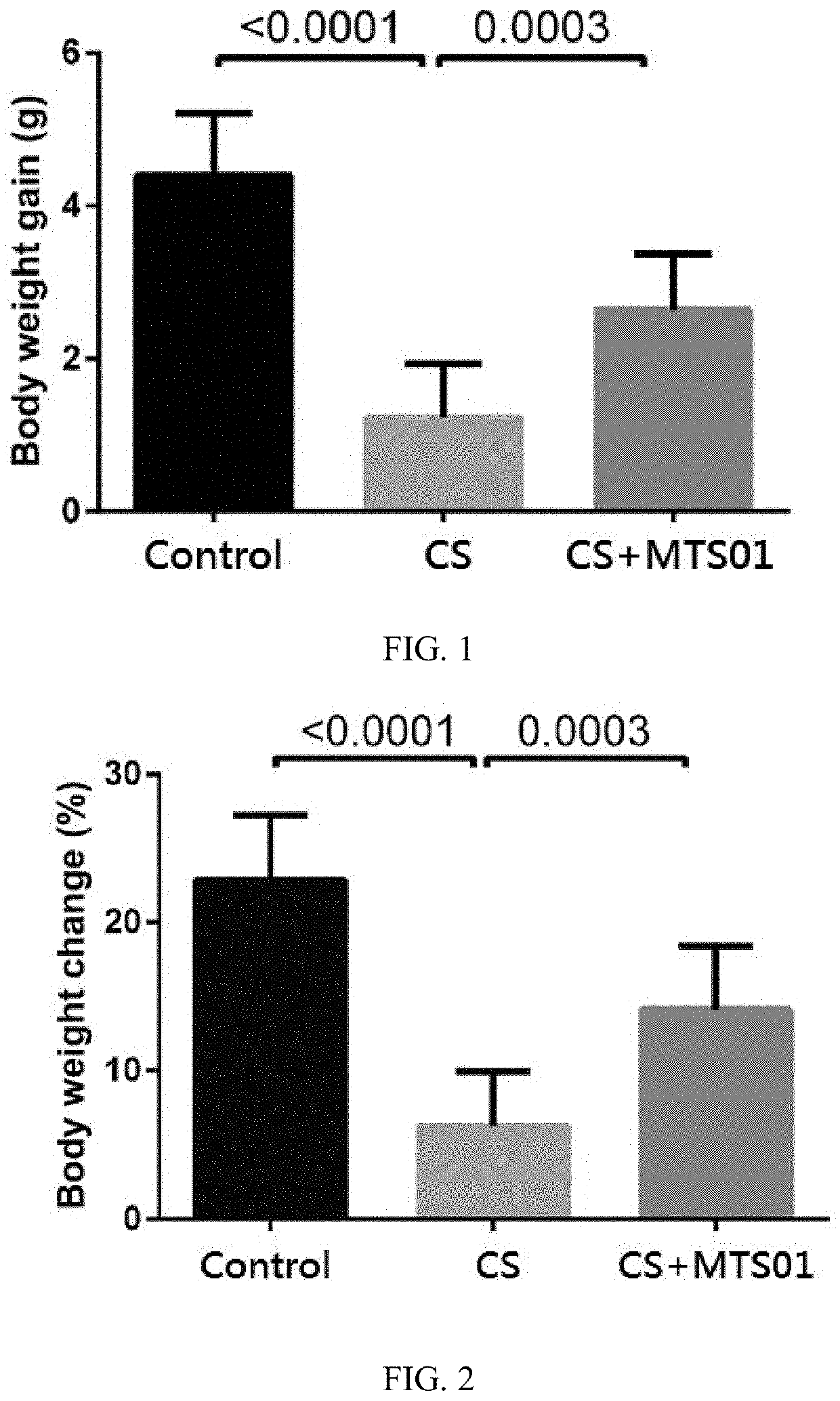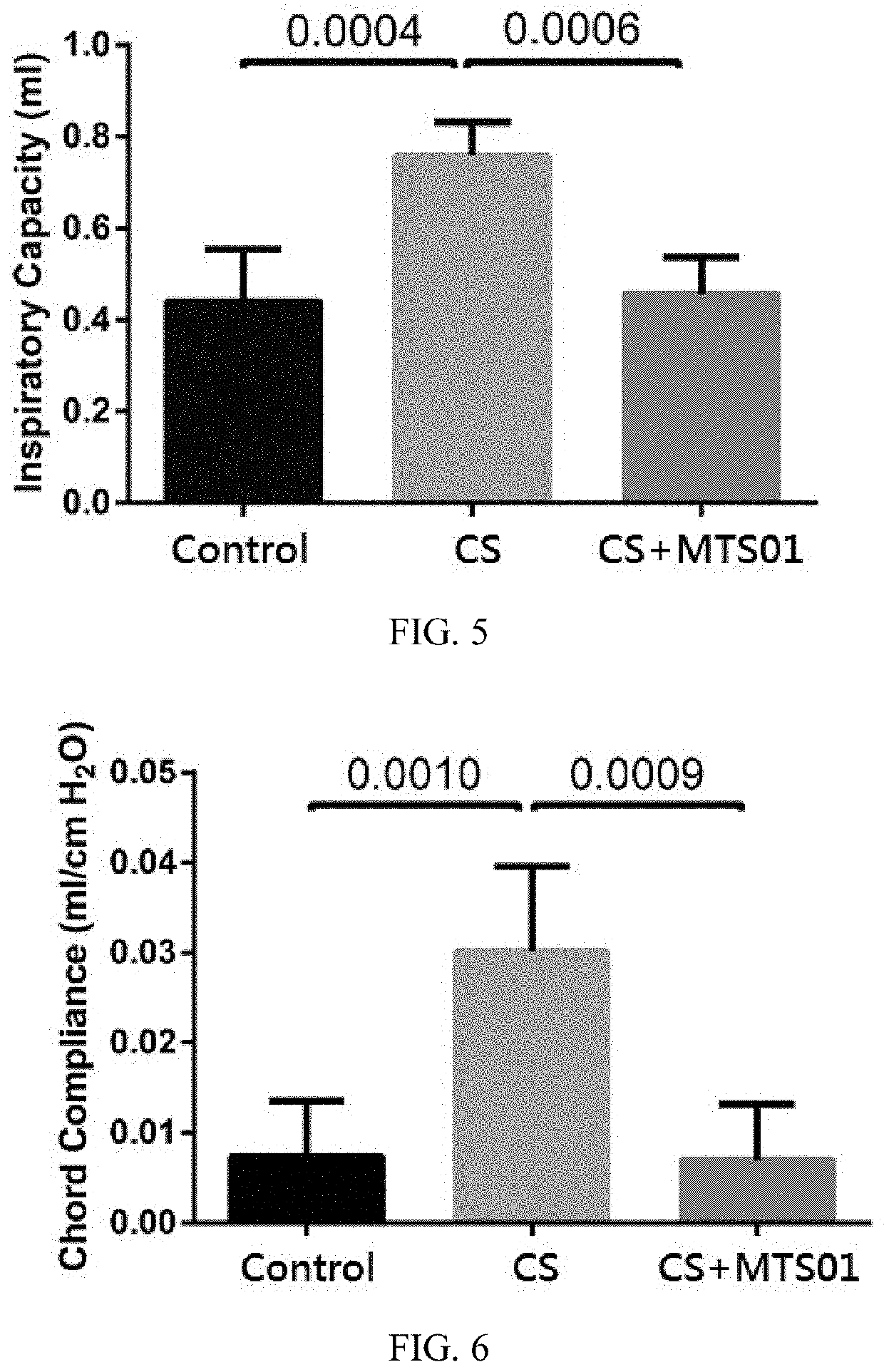Method of ameliorating chronic obstructive pulmonary disease using parabacteroides goldsteinii
a probiotic bacterium and parabacterium technology, applied in the field of using parabacteroides goldsteinii, can solve the problems of poor metabolic efficiency, poor weight loss of copd, and weakness of respiratory muscles, so as to improve lung function, improve weight loss, and reduce the inflammatory response of lung cells.
- Summary
- Abstract
- Description
- Claims
- Application Information
AI Technical Summary
Benefits of technology
Problems solved by technology
Method used
Image
Examples
example 1
[0044]Effect of Parabacteroides goldsteinii on Body Weight in Chronic Obstruction Pulmonary Mice
[0045]In order to investigate the effect of P. goldsteinii on improving the weight loss caused by the COPD, each of these three mouse model groups were monitored the body weight every week during the 12 weeks of the experimental duration. The calculation formula of body weight gain is final body weight (12 week) minus body weight of start point (0 week). For body weight change, the value of body weight gain divides to original body. The value presented by gram (FIG. 1) or percentage (FIG. 2). All statistical analyses were performed using standard one-way ANOVA with Dunnett's multiple comparison test (GraphPad prism 4.01; GraphPad Software Inc., San Diego, Calif.) (* p<0.05; ** p<0.01; *** p<0.001).
[0046]The results of the P. goldsteinii of the present invention for improving the weight loss of CS-induced COPD mice are shown in FIG. 1 and FIG. 2. As showing in FIG. 1 and FIG. 2, compared w...
example 2
[0047]Effect of Parabacteroides goldsteinii on the Emphysema, the Thickening of the Tracheal Wall, and the Lung Fibrosis in Chronic Obstruction Pulmonary Mice
[0048]In order to investigate the effect of P. goldsteinii on improving the emphysema, the thickening of the tracheal wall, the lung fibrosis caused by the COPD, the lungs of each of these three mouse model groups were fixed in buffered formalin and embedded in paraffin. Thin sections (4 mm) were prepared and stained with hematoxylin and eosin (H&E). Stained sections were examined under an optical light microscope (Olympus, Tokyo, Japan). Histological images were analyzed using the ImageJ software (National Institutes of Health, Bethesda, USA). Two randomly-selected fields from each 10-15 sections were analyzed.
[0049]The results of the P. goldsteinii of the present invention for improving the emphysema of CS-induced COPD mice are shown in FIG. 3. As showing in FIG. 3, compared with the control group, the alveolar wall of the mi...
example 3
[0051]Effect of Parabacteroides goldsteinii on the Abnormal Lung Function in Chronic Obstruction Pulmonary Mice
[0052]In order to investigate the effect of P. goldsteinii on improving the abnormal lung function caused by the COPD, after whole-body plethysmography, all mice of each of these three mouse model groups were anesthetized, tracheostomized, and placed in a forced pulmonary maneuver system (Buxco Research Systems, Wilmington, N.C.). An average breathing frequency of 100 breaths / min was imposed on the anesthetized animals. Three semi-automatic maneuvers including the Boyle's law functional residual capacity (FRC), quasistatic P-V, and fast flow volume maneuver were performed with the Buxco system. The FRC was determined with Boyle's law FRC.
[0053]To measure total lung capacity (TLC), residual volume (RV), inspiratory capacity (IC), vital capacity (VC), expiratory reserve volume (ERV), and chord compliance (Cchord), the quasistatic PV maneuver was performed.
[0054]Under the fast...
PUM
 Login to View More
Login to View More Abstract
Description
Claims
Application Information
 Login to View More
Login to View More - R&D
- Intellectual Property
- Life Sciences
- Materials
- Tech Scout
- Unparalleled Data Quality
- Higher Quality Content
- 60% Fewer Hallucinations
Browse by: Latest US Patents, China's latest patents, Technical Efficacy Thesaurus, Application Domain, Technology Topic, Popular Technical Reports.
© 2025 PatSnap. All rights reserved.Legal|Privacy policy|Modern Slavery Act Transparency Statement|Sitemap|About US| Contact US: help@patsnap.com



